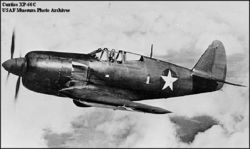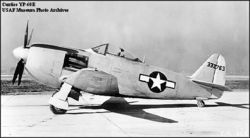PlaneSpottingWorld welcomes all new members! Please gives your ideas at the Terminal.
Curtiss YP-60
| Curtiss-Wright XP-53/P-60 | |
|---|---|
| XP-60 with Rolls-Royce Merlin engine. | |
| Type | Fighter aircraft |
| Manufacturer | Curtiss-Wright Corporation |
| Maiden flight | 1942-11-01 |
| Status | Cancelled 1941-12-20 |
| Primary user | United States Army Air Forces |
| Produced | 1942-1944 |
| Number built | 6 |


The Curtiss XP-53/P-60 was a single engine, single place, low wing monoplane fighter developed by the Curtiss-Wright as a successor to their P-40. It went through a lengthy series of prototype versions, eventually evolving into a design that bore no resemblance at all to the P-40. None of these versions showed enough promise to warrant production, however, and the plane was considered a failure by all.
Development
The initial design contained in proposals to the United States Army Air Corps was for an airplane based upon the P-40 design but featuring a low drag laminar flow wing, a Continental XIV-1430-3 inverted vee engine, and eight wing-mounted 0.5 inch machine guns. This proposal was accepted and a contract for two prototypes was issued on October 1, 1940 with the aircraft designated the XP-53.
Within two months the Army Air Corps modified the order to complete the second of the prototypes the Rolls-Royce Merlin engine in place of the XIV-1430. The aircraft was re-designated XP-60. The airframe design for the XP-60 was modified for the different engine, and the landing gear changed from the rearward retracting P-40 design to a new inward retracting version. This aircraft first flew on September 18, 1941 with a British-built Merlin 28 engine. The XP-53 prototype was then converted into an airframe static test vehicle for the XP-60.
Considering delivery delays of quantities of the Packard-built Merlin engines due to its use on other fighters, the use of a turbo-supercharged Allison V-1710-75 engine was considered in its place. Thus, on October 31, 1941 a contract for 1,950 P-60A fighters was awarded using the Allison engine.
In the meantime flight test of the XP-60 prototype was not progressing smoothly. In addition to landing gear problems, performance quantities were not being met due to shortcomings in the laminar-flow wing surface finish, and less than specified engine output performance. Thus, work on the P-60A was stopped on December 20, 1941, and then on January 2, 1942 the order was changed to produce one XP-60A with the Allison V-1710-75 engine and a General Electric B-14 turbo-supercharger, one XP-60B with the Allison V-1710-75 engine and a Wright SU-504-1 turbo-supercharger, and one XP-60C with the massive Chrysler XIV-2220 sixteen cylinder engine.
At this time availability of the Chrysler engine was coming into question, and after Curtiss noted that several hundreds of pounds of lead would be needed in the tail of the existing airframe to balance it, it was agreed to install a Pratt & Whitney R-2800 radial engine in the XP-60C. In the meantime, Curtiss installed a Merlin 61 engine in the original XP-60 and after enlarging the vertical tail surface, this aircraft was re-designated XP-60D.
The XP-60A first flew on November 1, 1942.
While official interest in the P-60 waned during the summer of 1942, interest due to the promise of improved performance with the installation of the R-2800 engine resulted in a contract for 500 R-2800 powered P-60A-1-CU fighters with contra-rotating propellers. With concern that the contra-rotating propellers would not be available on time, the XP-60B was modified to take the R-2800-10 engine driving a four bladed propeller. This modification was re-designated XP-60E.
On January 27, 1943 the XP-60C flew for the first time, powered by a R-2800-53 engine with contra-rotating propellers. The aircraft's characteristics were found to be generally satisfactory. First flight of the XP-60E, with the four-bladed propeller, was delayed until May 26, 1943 after it was found that due to its lighter weight the engine installation had to be moved ten inches forward compared to the XP-60C.
In April 1943, the Army Air Force decided to conduct an evaluation of the various fighter aircraft in development and use in order to eliminate the least desirable models. Curtiss was requested to have the XP-60E participate. As the XP-60E was not available, the company hurriedly prepared the XP-60C for the evaluation at Patterson Field. In the event, due to various issues, the XP-60C performed poorly, resulting in reduction of the production run of 500 aircraft to two aircraft.
In January 1944, the XP-60E was flown to Eglin Field for official trials, where Army Air Force pilots found that it did not compare favorably to later aircraft. When Curtiss expressed the desire to abandon further work on the P-60 series, the Army Air Force insisted upon completion of one of the two aircraft in construction. The aircraft when originally ordered was designated YP-60A-1-CU was re-designated YP-60E. This aircraft flew on July 13, 1944 and subsequently delivered to Wright Field. The YP-60E differed mainly from the XP-60E in being powered by a 2,100 hp R-2800-18 engine and an all-round vision bubble cockpit canopy.
Specifications (XP-60C)
General characteristics
- Crew: 1
- Length: 33 ft 11 in (10.34 m)
- Wingspan: 41 ft 4 in (12.60 m)
- Height: 12 ft 4 in (3.76 m)
- Wing area: 275 ft² (25.6 m²)
- Empty weight: 8,698 lb (3,945 kg)
- Loaded weight: 10,785 lb (4,892 kg)
- Powerplant: 1× Pratt & Whitney R-2800-53 radial engine, 2,000 hp (1,500 kW)
Performance
- Maximum speed: 414 mph (360 knots, 666 km/h)
- Service ceiling: 37,900 ft (11,600 m)
- Rate of climb: 3,890 ft/min (19.8 m/s)
- Wing loading: 39.2 lb/ft² (191 kg/m²)
- Power/mass: 0.19 hp/lb (300 W/kg)
Armament
- Guns: 4× .50 in (12.7 mm) M2 Browning machine guns
References
- Green, William (1961). War Planes of the Second World War - Fighters, Volume 4. London: Macdonald.
Related content
Related development
Designation sequence
- XP-50 - P-51 - XP-52 - XP-53 - XP-54 - XP-55 - XP-56 - XP-57 - XP-58 - P-59 - P-60 - P-61 - XP-62 - P-63
Related lists
Lists relating to aviation | |
|---|---|
| General | Timeline of aviation · Aircraft · Aircraft manufacturers · Aircraft engines · Aircraft engine manufacturers · Airports · Airlines |
| Military | Air forces · Aircraft weapons · Missiles · Unmanned aerial vehicles (UAVs) · Experimental aircraft |
| Notable incidents and accidents | Military aviation · Airliners · General aviation · Famous aviation-related deaths |
| Records | Flight airspeed record · Flight distance record · Flight altitude record · Flight endurance record · Most produced aircraft |
